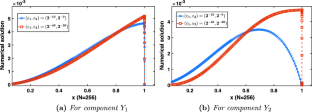Efficient approximation of solution derivatives for system of singularly perturbed time-dependent convection-diffusion PDEs on Shishkin mesh
Abstract
This article deals with a coupled system of singularly perturbed convection-diffusion parabolic partial differential equations (PDEs) possessing overlapping boundary layers. As the thickness of the layer shrinks for small diffusion parameter, efficient capturing of the solution and the diffusive flux (i.e., scaled first-order spatial derivative of the solution) leads to a difficult task. It is well-known that the classical numerical techniques have deficiencies in estimating the solution and the diffusive flux on equidistant mesh unless the mesh-size is adequately large. We aim to generate an efficient numerical approximation to the coupled system of PDEs by employing the implicit-Euler method in time and a classical finite difference scheme in space on a layer-adapted Shishkin mesh. Firstly, we discuss about parameter-uniform convergence of the numerical solution in \(C^0\)-norm followed by the error analysis for the scaled discrete space derivative and the discrete time derivative. Subsequently, the parameter-uniform error bound is established in weighted \(C^1\)-norm for global approximation to the solution and the space-time solution derivatives. The theoretical findings are verified by generating the numerical results for two test examples.


 求助内容:
求助内容: 应助结果提醒方式:
应助结果提醒方式:


